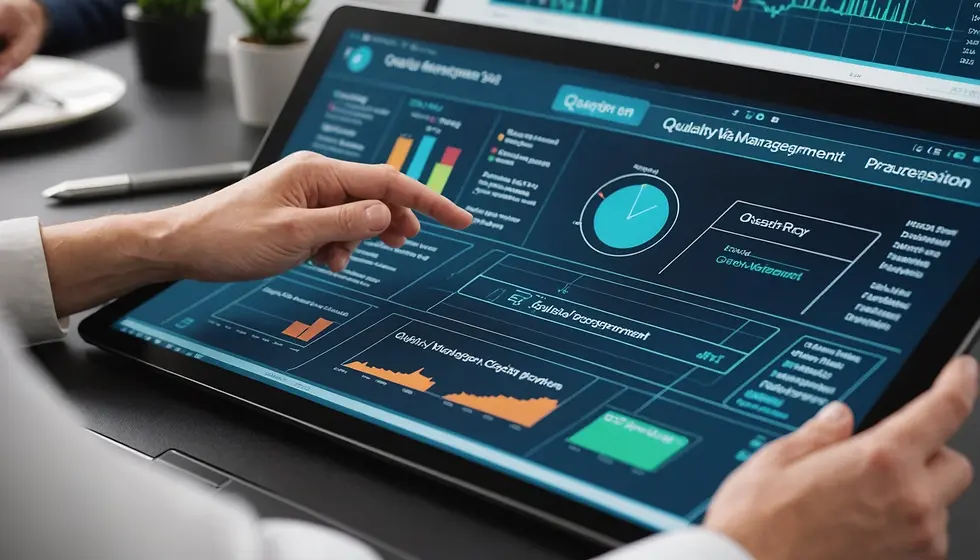Optimizing ISO 9001 Documented Information: Unveiling Professional Standards and Unknown Narratives
- islam Arid

- Sep 23
- 5 min read
Managing documented information is crucial for creating and sustaining an effective Quality Management System (QMS) based on ISO 9001 standards. In today’s fast-paced business environment, the importance of ISO 9001 cannot be overstated; it provides a roadmap for organizations to achieve improved quality, enhanced customer satisfaction, and greater operational efficiency. As industries grow more complex, understanding the intricacies of documented information becomes vital.
This guide will cover essential concepts related to ISO 9001 Documented Information, effective management practices, and insightful strategies to promote continuous improvement and operational excellence.
Understanding ISO 9001 Documented Information
ISO 9001 requires organizations to maintain well-structured documented information to successfully implement and manage their QMS. This documentation serves several purposes, including ensuring compliance with the standard, facilitating knowledge transfer, and serving as a reference for training.
The Importance of Documented Information
Documented information is essential in fostering a culture of quality within an organization. It clarifies roles, responsibilities, and processes. For instance, companies with clear documented procedures have reported a 20% decrease in operational errors. Without organized documentation, businesses risk disarray, leading to inefficiencies and rising nonconformities.
By ensuring that every document is accurate, accessible, and pertinent, organizations can enhance operational performance and prepare for ISO 9001 audits more effectively.
Types of Documented Information
ISO 9001 specifies several types of documented information that organizations must maintain:
Quality Policy: This is a declaration from senior management outlining the organization’s quality objectives and commitment to quality.
Quality Manual: It defines the policies of the QMS and provides guidance on its structure.
Procedures: Detailed descriptions on how to carry out specific processes to achieve desired results.
Work Instructions: Step-by-step guidance for performing particular tasks efficiently.
Records: Documentation that evidences compliance with ISO 9001 requirements, including training records, customer feedback, and audit reports.
Organizing documented information in this way enables better management and control of the documentation system.
The Role of Document Control in ISO 9001
Document control is a fundamental requirement of ISO 9001. It ensures that all documented information is properly created, reviewed, revised, and approved before use.
Key Aspects of Document Control
Creation and Approval: Create a clear procedure for developing and approving documents. This ensures the accuracy of the documentation and that it meets established quality standards.
Review and Update: Regularly review and update documents to maintain their relevance and compliance with evolving standards or internal requirements.
Distribution: Ensure approved documents are easily accessible to employees who need them. For example, a survey from the International Organization for Standardization indicated that easy access to documentation improves employee efficiency by up to 30%.
Obsolete Document Management: Develop a system for managing obsolete documents to prevent the use of outdated information. This involves marking documents as obsolete and keeping them for reference.
A solid document control system fosters compliance with ISO 9001 and improves efficiency within the organization.
Implementing Effective Documented Information Practices
While knowing the requirements of ISO 9001 is vital, effectively implementing documented information practices is equally crucial. Here are effective strategies for optimizing documented information.
Training and Development
Provide comprehensive training on document management practices for employees. This training ensures that everyone understands how to create, revise, and control documented information following the organization’s policies. For example, companies can observe a 25% increase in compliance levels with thorough training programs.
Software Solutions
Utilize technology to enhance document management processes. Various software options can automate aspects of document control, making it easier to track revisions and approvals. Implementing such tools can reduce the time spent on documentation tasks by nearly 40%.
Performance Metrics
Establish and monitor performance metrics related to document management. Key performance indicators (KPIs) could include the number of documents created, reviewed, and approved each month. Tracking these metrics can pinpoint areas needing improvement and propel continuous enhancement efforts.
Foster a Quality Culture
Encourage a quality-centric culture that values documented information. Employees should understand that quality documentation is crucial to achieving organizational goals, rather than seeing it as mere bureaucracy.
Conducting ISO 9001 Audits for Documented Information
ISO 9001 audits are vital for assessing the effectiveness of documented information management. Regular internal audits can help identify nonconformities and improvement areas in document control practices.
Preparing for an ISO 9001 Audit
To prepare for an ISO 9001 audit, follow these steps:
Audit Planning: Set an audit schedule and establish the audit's scope, placing specific emphasis on documented information.
Documentation Review: Perform a pre-audit evaluation of documented information to ensure compliance with ISO 9001.
Employee Engagement: Engage employees involved in documentation processes to ensure they understand their roles during the audit.
Corrective Actions: Prepare to address any nonconformities identified in the audit. A clear corrective action plan is essential for rectifying issues and preventing them from recurring.
Post-Audit Follow-Up
After the audit, review findings thoroughly and create an action plan for improvement. Assign responsibilities to team members for addressing any issues related to documented information, setting deadlines for completion.
Risk Management and Documented Information
A key focus of ISO 9001 is risk management. Organizations must proactively identify and address risks tied to documented information management.
Identifying Risks
Start by identifying potential risks related to document control, such as:
Loss of essential documents
Unauthorized access to sensitive information
Inaccurate or outdated documentation
Mitigating Risks
Once risks are identified, develop strategies to mitigate them. This may involve implementing secure access controls, conducting regular document reviews, and having backup solutions for critical information.
Proactively managing risks helps organizations strengthen their quality management efforts and adhere to ISO 9001 standards.
Continuous Improvement through Documented Information
ISO 9001 emphasizes continuous improvement. Organizations should use documented information as a foundation for identifying improvement opportunities.
Leveraging Feedback
Gather feedback from employees, customers, and stakeholders to refine documentation practices. Input can highlight where processes need adjustments or where additional documentation might be needed.
Performance Reviews
Conduct frequent assessments of performance metrics related to document management. Use this data to guide strategic decisions and continuously enhance QMS effectiveness.
Management Review Process
Implement a robust management review process to evaluate the QMS and the effectiveness of documented information. Reviews should concentrate on:
Progress toward quality objectives
Evaluation of nonconformities and corrective actions taken
Effectiveness of document control processes
Incorporating continuous improvement principles into document management practices allows organizations to boost quality management and overall performance.
The Journey Ahead
Optimizing ISO 9001 documented information is an ongoing process requiring commitment and attention to detail. By implementing effective document control practices, promoting a quality culture, and emphasizing continuous improvement, organizations can ensure compliance with ISO 9001 standards while enhancing operational excellence.
As the domain of quality management continues to evolve, embracing innovative technologies and practices will further bolster documented information management. By staying informed and flexible, organizations can effectively navigate the complexities of ISO 9001, ensuring their quality management system is a powerful asset for reaching business objectives and driving customer satisfaction.
























Comments